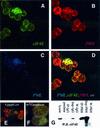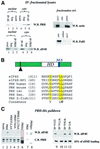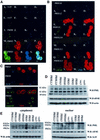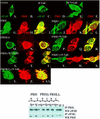The proline-rich homeodomain protein, PRH, is a tissue-specific inhibitor of eIF4E-dependent cyclin D1 mRNA transport and growth
- PMID: 12554669
- PMCID: PMC140753
- DOI: 10.1093/emboj/cdg069
The proline-rich homeodomain protein, PRH, is a tissue-specific inhibitor of eIF4E-dependent cyclin D1 mRNA transport and growth
Abstract
The translation initiation factor eIF4E is involved in the modulation of cellular growth. In the nucleus, where eIF4E is associated with PML nuclear bodies, eIF4E mediates nucleocytoplasmic transport of specific transcripts, and this contributes to its transformation activity. Surprisingly, we found that a trans cription factor, the proline-rich homeodomain protein PRH, is a negative regulator of eIF4E in myeloid cells, interacting with eIF4E through a conserved binding site typically found in translational regulators. Through this interaction, PRH inhibits eIF4E-dependent mRNA transport and subsequent transformation. These activities of PRH are independent of its transcriptional functions. Further, we found that 199 homeodomain proteins contain potential eIF4E-binding sites. Thus, there could be many tissue-specific regulators of eIF4E. These findings provide a model for regulation of a general factor, eIF4E, in tissue- specific contexts, and suggest that its regulation is important in differentiation and development.
Figures









Similar articles
-
Eukaryotic translation initiation factor 4E activity is modulated by HOXA9 at multiple levels.Mol Cell Biol. 2005 Feb;25(3):1100-12. doi: 10.1128/MCB.25.3.1100-1112.2005. Mol Cell Biol. 2005. PMID: 15657436 Free PMC article.
-
Aberrant eukaryotic translation initiation factor 4E-dependent mRNA transport impedes hematopoietic differentiation and contributes to leukemogenesis.Mol Cell Biol. 2003 Dec;23(24):8992-9002. doi: 10.1128/MCB.23.24.8992-9002.2003. Mol Cell Biol. 2003. PMID: 14645512 Free PMC article.
-
PML RING suppresses oncogenic transformation by reducing the affinity of eIF4E for mRNA.EMBO J. 2001 Aug 15;20(16):4547-59. doi: 10.1093/emboj/20.16.4547. EMBO J. 2001. PMID: 11500381 Free PMC article.
-
The emerging roles of translation factor eIF4E in the nucleus.Differentiation. 2002 Mar;70(1):10-22. doi: 10.1046/j.1432-0436.2002.700102.x. Differentiation. 2002. PMID: 11963652 Review.
-
Regulation of cap-dependent translation by eIF4E inhibitory proteins.Nature. 2005 Feb 3;433(7025):477-80. doi: 10.1038/nature03205. Nature. 2005. PMID: 15690031 Review.
Cited by
-
Protein kinase CK2 inactivates PRH/Hhex using multiple mechanisms to de-repress VEGF-signalling genes and promote cell survival.Nucleic Acids Res. 2012 Oct;40(18):9008-20. doi: 10.1093/nar/gks687. Epub 2012 Jul 25. Nucleic Acids Res. 2012. PMID: 22844093 Free PMC article.
-
Emx2 homeodomain transcription factor interacts with eukaryotic translation initiation factor 4E (eIF4E) in the axons of olfactory sensory neurons.Proc Natl Acad Sci U S A. 2004 Jul 20;101(29):10815-20. doi: 10.1073/pnas.0403824101. Epub 2004 Jul 9. Proc Natl Acad Sci U S A. 2004. PMID: 15247416 Free PMC article.
-
Mnk2 and Mnk1 are essential for constitutive and inducible phosphorylation of eukaryotic initiation factor 4E but not for cell growth or development.Mol Cell Biol. 2004 Aug;24(15):6539-49. doi: 10.1128/MCB.24.15.6539-6549.2004. Mol Cell Biol. 2004. PMID: 15254222 Free PMC article.
-
Hhex inhibits cell migration via regulating RHOA/CDC42-CFL1 axis in human lung cancer cells.Cell Commun Signal. 2021 Jul 28;19(1):80. doi: 10.1186/s12964-021-00763-6. Cell Commun Signal. 2021. PMID: 34321041 Free PMC article.
-
Regulation of Translation by TOR, eIF4E and eIF2α in Plants: Current Knowledge, Challenges and Future Perspectives.Front Plant Sci. 2017 Apr 26;8:644. doi: 10.3389/fpls.2017.00644. eCollection 2017. Front Plant Sci. 2017. PMID: 28491073 Free PMC article. Review.
References
-
- Altmann M., Muller,P.P., Pelletier,J., Sonenberg,N. and Trachsel,H. (1989) A mammalian translation initiation factor can substitute for its yeast homologue in vivo. J. Biol. Chem., 264, 12145–12147. - PubMed
Publication types
MeSH terms
Substances
Grants and funding
LinkOut - more resources
Full Text Sources
Other Literature Sources
Molecular Biology Databases
Research Materials

